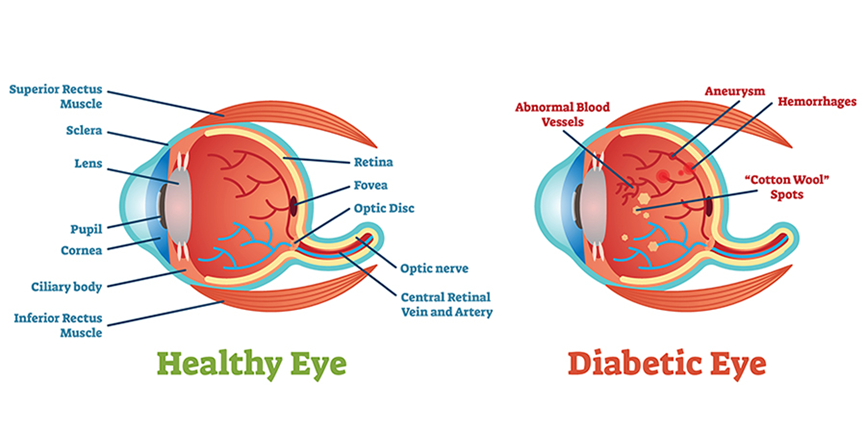Home » Blog » What Is Diabetic Retinopathy?
What Is Diabetic Retinopathy?
Posted by: Montgomery Eye Physicians in General
According to the American Academy of Ophthalmology, diabetic retinopathy is an eye disease that affects people with diabetes. Diabetic Retinopathy is when high blood sugar levels cause damage to blood vessels in the retina. These blood vessels can swell and leak. Or they can close, stopping blood from passing through. Sometimes abnormal new blood vessels grow on the retina. Unfortunately, all these changes can steal your vision.

The Two Main Stages of Diabetic Eye Disease
NPDR (non-proliferative diabetic retinopathy)
This is the early stage of diabetic eye disease. Patients who have had diabetes for five years stand a 25% chance of developing non-proliferative diabetic retinopathy (NPDR).
With NPDR, tiny blood vessels leak, making the retina swell. When the macula swells, it is called macular edema. This is the most common reason why people with diabetes lose their vision.
PDR (proliferative diabetic retinopathy)
PDR is the more advanced stage of diabetic eye disease. It happens when the retina starts growing new blood vessels. This is called neovascularization. These fragile new vessels often bleed into the vitreous. If they only bleed a little, you might see a few dark floaters. If they bleed a lot, it might block all vision.
These new blood vessels can form scar tissue. Scar tissue can cause problems with the macula or lead to a detached retina.
PDR is very serious and can steal both your central and peripheral (side) vision.
Diabetic Retinopathy Symptoms
You can have diabetic retinopathy and not know it. This is because it often has no symptoms in its early stages. As diabetic retinopathy gets worse, you will notice symptoms such as:
- seeing an increasing number of floaters
- blurry vision
- vision that sometimes changes from blurry to clear,
- seeing blank or dark area in your field of vision
- poor night vision
- noticing colors appear faded or washed out
- losing vision.
Diabetic retinopathy symptoms usually affect both eyes.
Risk Factors
Risk factors relating to diabetic retinopathy are identical to factors that aggravate diabetes, which include:
- Obesity: Excess fat within the blood and body tissue makes it harder for insulin to regulate blood sugar levels effectively.
- Inactivity: Inactivity results in slow body metabolism, subsequently favoring high blood sugar levels
- Family History: Genetic factors affecting the pancreas cause inadequate production of insulin resulting in abnormally high blood sugar levels
- Age: The pancreas ability to produce adequate insulin decreases as a person get older
- High Blood Pressure: The super-thin blood vessels within the retina rapture easily as a result of the abnormally high blood pressure
Check out this video to learn more about diabetic retinopathy
If you are 1 in 10 who have diabetes, you can effectively delay the condition’s onset by making healthy lifestyle choices. However, it is prudent to have a yearly eye checkup to allow your eye doctor to determine diabetic retinopathy onset when you have diabetes.
Your healthy eyesight is our HIGHEST priority, and we love being your partner in vision health!
References:
American Academy of Ophthalmology
American Optometric Association
Centers of Disease Control (CDC)
